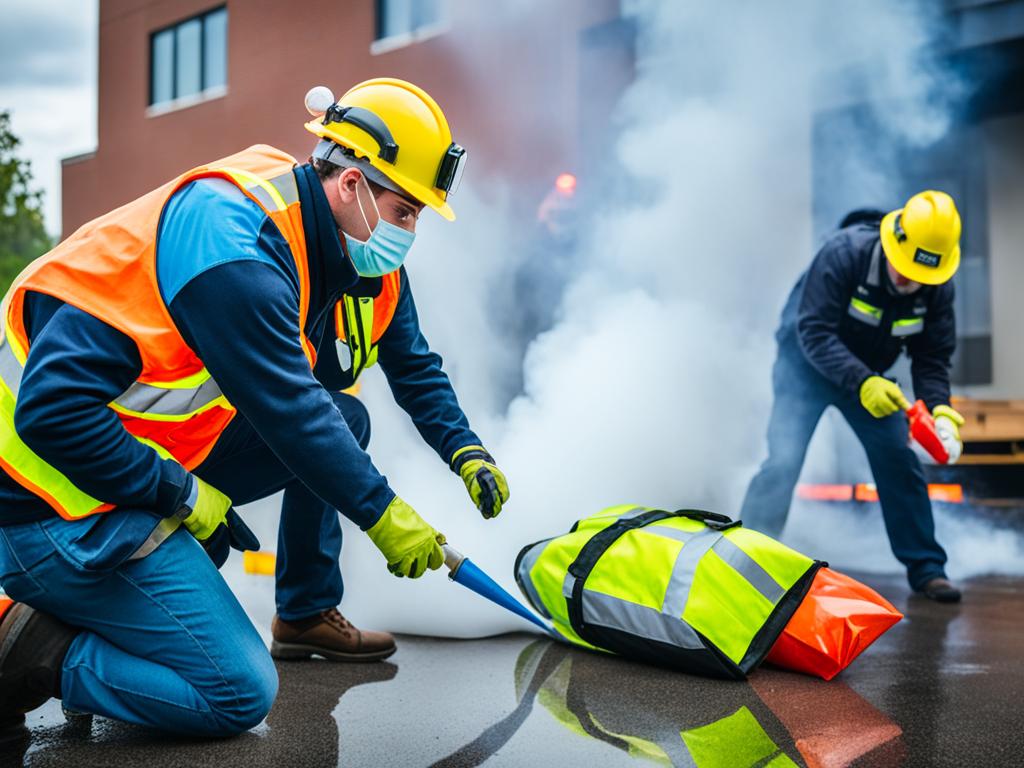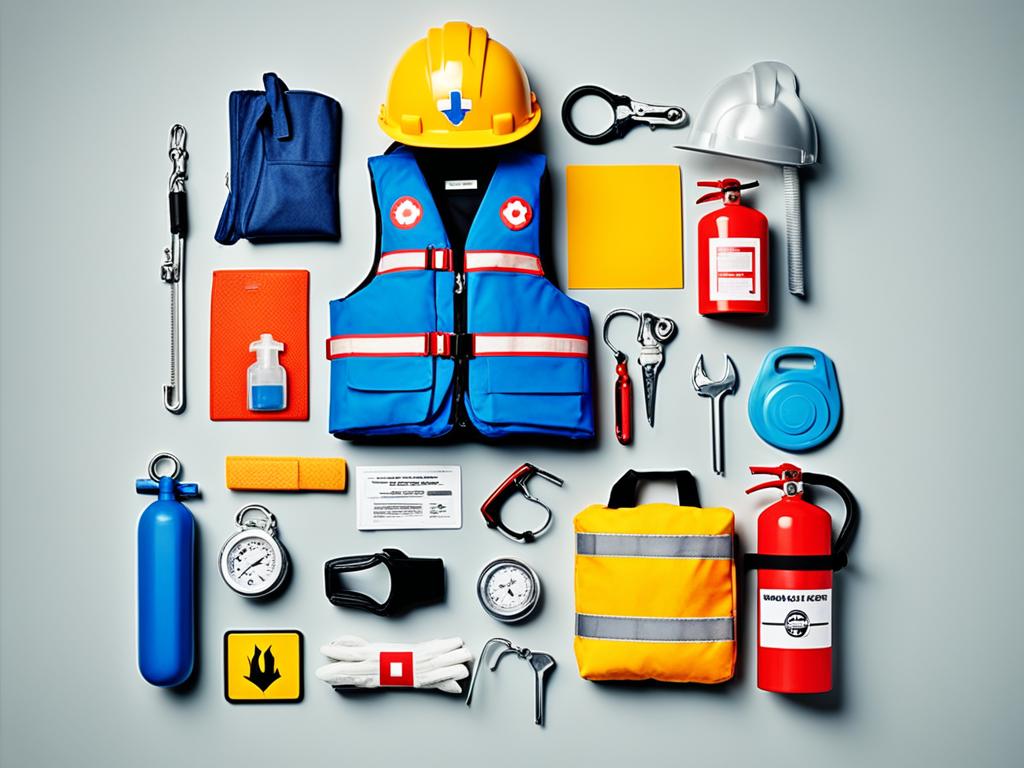Imagine facing a sudden crisis. Your heart pounds fast – do you know how to react? My journey into survival techniques wasn’t sudden. It was a clear choice to be ready for anything. Today, I’ll share key points on crisis prevention methods, survival strategies, and survival training. It’s more than just learning steps. It’s about building the confidence to tackle emergencies without fear.
Key Takeaways
- Recognize the importance of everyday readiness and proactive planning for crisis situations.
- Discover the foundational crisis prevention methods that can significantly reduce risks in emergencies.
- Explore the various survival strategies that are essential in the face of unforeseen disasters.
- Understand why comprehensive survival training is a non-negotiable aspect of personal and community safety.
- Learn to identify and develop the skills that will help you manage and navigate through crises effectively.
- Gain insights into how preparedness can empower resilience and peace of mind in turbulent times.
Understanding the Fundamentals of Crisis Prevention
Learning about crisis prevention is complex but crucial. It’s like mastering chess: detailed, strategic, and focused on protecting what’s important. Disaster readiness is essential for everyone. It keeps our daily lives safe and helps protect everyone involved.
The world of crisis management is always changing because the threats we face change too. To keep up, we must look closely at what works best in crisis management. By studying real-life examples from groups like FEMA and the Red Cross, we learn how to respond better to emergencies.
| Component | Description | Example |
|---|---|---|
| Risk Assessment | Analysis of potential threats and vulnerabilities within an environment. | Identifying flood-prone areas near a manufacturing plant. |
| Preventative Measures | Strategies and actions implemented to avert or diminish impact. | Regular fire drills and installing smoke detectors in an office building. |
| Response Planning | Coordinated approach to dealing with the immediate effects of a crisis. | A designated evacuation route and communication strategy during an earthquake. |
| Recovery Strategies | Plans to restore normalcy and reinforce post-crisis resilience. | Business continuity planning for post-natural disaster scenarios. |
This idea is popular among experts in emergency response. They believe that regular practice makes preparedness second nature. Turning these concepts into automatic actions is what makes crisis prevention work well.
Are we ready to face a crisis? To know, we must compare our plans to their real-world success. Building earthquake-safe structures and developing drought-resistant crops show how we’re acting to prevent crises. By learning, practicing, and working together, our ability to face unexpected challenges gets stronger.
The Essential Survival Skills Everyone Should Know
Learning emergency response and survival training is crucial. It’s important to have fundamental survival skills. These skills could save your life in emergencies.
Securing Shelter and Warmth
Securing shelter and warmth is a top priority. Hypothermia from losing body heat can be dangerous. A well-built shelter protects you from bad weather.
Use natural materials like branches, leaves, or snow for insulation. The shelter must be small enough to keep warm easily.
Finding and Purifying Water
Water is essential for life, especially in survival situations. You must find and purify water to stay hydrated. Use streams, rivers, or dew as sources.
Boiling, chemical purification, or filtration can make water safe. It’s critical to avoid waterborne illnesses by purifying water.
Signaling Methods in an Emergency
Being able to signal for help can save you. It’s vital to know different ways to signal in emergencies. You can use whistles, reflective mirrors, or fire for signals.
The ‚SOS‘ signal is universal for help. Make sure your signals are in an open space. They should stand out clearly.
| Survival Skill | Why It’s Important | Tools/Methods |
|---|---|---|
| Shelter Building | Prevents hypothermia and shields from elements | Branches, Leaves, Snow, Tarp |
| Water Purification | Ensures hydration without illness from contaminants | Boiling, Chemical Tablets, Filters |
| Emergency Signaling | Attracts the attention of rescuers | Whistles, Mirrors, Fire, ‚SOS‘ signals |
Having key survival skills is vital for handling emergencies. Practice these skills often with survival training. Being well-prepared increases your chance of survival.

Building an Effective Emergency Preparedness Plan
To ensure your disaster readiness, creating a detailed emergency plan is essential. This plan should highlight quick emergency response steps and prepare you for unexpected events. It’s crucial to assess risks, manage resources, and have backup plans to enhance your preparedness.
Start by identifying possible emergencies specific to your area, like hurricanes or wildfires. Consider other crises too, such as power outages and health emergencies. Once you know the risks, create strategies for each possible scenario.
Building an emergency kit is a fundamental step. Your kit must have supplies to last at least 72 hours. Include items like non-perishable food, water, first-aid kits, flashlights, extra batteries, a hand-crank radio, and hygiene products.
Evacuation plans and family communication must not be ignored. Make sure your family knows the evacuation routes and how to reconnect if separated. Include plans for meeting points and alternate communication methods if phones don’t work.
| Item | Purpose | Quantity |
|---|---|---|
| Water | Hydration | 1 gallon per person per day |
| Food | Sustenance | Enough for 3 days |
| First-Aid Kit | Medical Emergencies | 1 kit |
| Flashlight | Visibility | 1 per person |
| Radio | Information | 1 battery-powered or hand-crank |
Also, don’t overlook essential documents. Keep copies of important papers like birth certificates and insurance policies in waterproof containers. Think about using secure cloud storage for digital copies.
Paying attention to details can significantly impact your emergency response. Continuously update and practice your plan so everyone knows what to do in an emergency. In future articles, we’ll explore more on preparedness, including how to handle stress and stay ready for disasters. Together, we’ll get ready to confidently face any surprise with skill.
Emergency Response: Staying Calm Under Pressure
In an emergency, keeping calm is very important. It’s not just about knowing what to do. It’s also about handling stress well in tough times. Using psychological strategies and practical methods is key to managing stress and being efficient when things go wrong.
The Psychology of Crisis Management
How our minds react to stress is key to managing crises well. During emergencies, our fight-or-flight response can make it hard to think and act right. That’s why being mentally ready is as important as having physical skills. Training your brain to handle stressful situations thoughtfully helps keep you calm and focused.
“In the face of crisis, the wise build bridges, while the foolish build barriers.”
This mental strength sets apart the best crisis responders from those who are unprepared.
Breathing Techniques for Stress Control
Controlled breathing is great for dealing with stress in emergencies. Deep breathing helps settle your heartbeat, clear your mind, and make better decisions. You focus on taking slow, deep breaths. This helps lessen stress reactions and improve crisis management.

- Sit in a comfortable position or lie flat on your back, knees bent, feet flat on the floor.
- Place one hand on your belly, just below your ribs, and the other hand on your chest.
- Breathe in deeply through your nose, letting your belly push your hand out. Your chest should stay still.
- Exhale through pursed lips, like whistling. Use the hand on your belly to help push all the air out.
- Do this breathing pattern 3 to 10 times, taking your time with each breath.
Adding these breathing techniques to your training can greatly improve your response to emergencies. It’s about making your mind and body work together. This way, they can perform their best when you face a crisis.
Disaster Readiness: Preparing for the Unexpected
Being ready for a disaster means there’s no such thing as too prepared. I’ve learned a lot about emergency preparedness. These strategies help lessen the blow of disasters. Whether it’s nature’s fury or human error, using various crisis prevention methods protects us, our loved ones, and our neighborhoods.
Knowing what dangers might come our way is key. We must actively look for info and updates on possible threats. Doing checks regularly helps us tweak our plans to stay ahead of new dangers.
Making our homes safer is crucial. This step makes disaster readiness real, like putting up storm shutters or making earthquake-ready improvements. Bringing the community together adds another layer of protection. Working with others can make a big difference in emergencies, helping everyone get the support and resources they need.
Insurance is also important in emergency preparedness. Here’s a quick look at how insurance helps:
| Type of Insurance | Coverage | Benefits in Disaster Situations |
|---|---|---|
| Homeowner’s Insurance | Property damage, living expenses if displaced | Key for rebuilding and covering living costs if you can’t stay home |
| Health Insurance | Medical treatments, emergency services | Gets you care right away without huge costs |
| Auto Insurance | Vehicle repair, replacement costs | Keeps you moving when it’s most needed |
| Life Insurance | Death benefit to beneficiaries | Helps keep your family stable financially after you’re gone |
Exploring crisis prevention methods has shown me the best strategies become part of our everyday life. Preparing in advance helps us react better to surprises. By truly adopting a whole-life view of disaster readiness, we’re not just ready for emergencies. We also build a culture of resilience that helps everyone around us.
Crisis Management Training: Simulations and Drills
I’m really into crisis management training. I think experiencing it hands-on is key. Doing simulations and drills teaches us important survival strategies. When you actually have to respond to an emergency, this training can make a big difference. We need to do more than just react; we must respond with confidence and know-how. And that gets better with practice. Let’s look at how practicing a lot and learning from before can make us more ready.
Conducting Regular Practice Drills
Knowing what to do in emergencies is one thing. Actually doing it when stressed is something else. That’s why I’m all for practice drills. When you practice facing a crisis, the right actions start to come naturally. It could be practicing how to get out quickly, handling a medical emergency, or knowing how to communicate. Each type of drill makes us sharper and better at responding to emergencies.
Learning from Past Disaster Scenarios
We can learn a lot from past disasters. Looking back at these situations helps us make our survival strategies stronger. We see what worked well and what didn’t. This way, we can improve how we respond to emergencies. Learning from the past gears us up better for the future. It’s like standing on the shoulders of those experiences to get better prepared.
In each drill and review session, we’re doing more than just going through the steps. We’re building a mindset that’s more tough and quick to respond. Sharing the know-how and hands-on parts of crisis management training is my aim. I want us to be ready for anything, to face it head-on, not caught off guard.
Advanced Mastery of Survival Techniques and Crisis Prevention
Exploring Master Survival Techniques and Crisis Prevention means getting into complex strategies. It’s about tailoring skills to fit many crisis situations. This could mean staying safe in the wild or making it through a city disaster.
Advanced Survival Strategy Development
A good survival strategy changes as needed. It goes beyond basics to include little details that save lives. We must keep improving our skills to be ready for anything.
Customizing Techniques to Different Crisis Situations
Survival strategies must fit the situation. We use lessons from real cases and experts to create flexible methods. These can be adjusted for any crisis we might face.
| Environment | Key Survival Techniques | Unique Crisis Prevention Methods |
|---|---|---|
| Wilderness | Advanced foraging, shelter building, signal crafting | Risk mapping and wildlife encounter protocols |
| Urban | Resource acquisition, navigation, emergency signaling | Infrastructure familiarity, urban evacuation tactics |
| Maritime | Sea navigation, water sourcing, distress signal procedures | Ship abandonment protocol, floatation device improvisation |
This journey teaches us valuable skills for facing any disaster. The aim is to not just survive but to thrive. Being resilient and resourceful is our main goal.
Conclusion
Our journey through survival skills and emergency preparedness has been deep. It shows the true value these skills have in today’s fast-paced world. We’ve looked into the heart of crisis prevention. This wasn’t just about learning the steps, but understanding the stakes involved. We began by breaking down basic crisis techniques and their impact on safety for us and others.
We moved from basic disaster readiness to advanced survival strategies. I shared tips to help you save lives – finding shelter, water, and staying calm. My goal was to light your way to a solid emergency plan. I wanted to boost your confidence to handle surprises. By covering crisis management and using real-life examples, I hoped to encourage ongoing practice and learning.
In closing, staying alert, informed, and skilled is key. Learning survival skills is not just for you but for the community too. If these words motivate you to improve your readiness, we’ve made progress toward a prepared world. Let this collection of survival tips be your beacon to a safer future.

